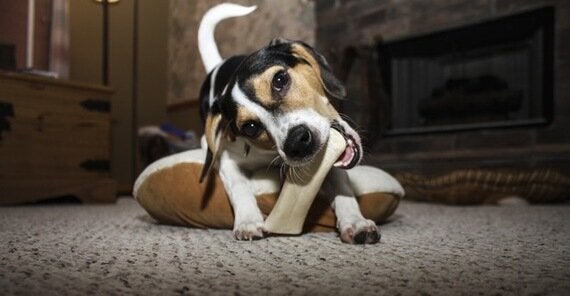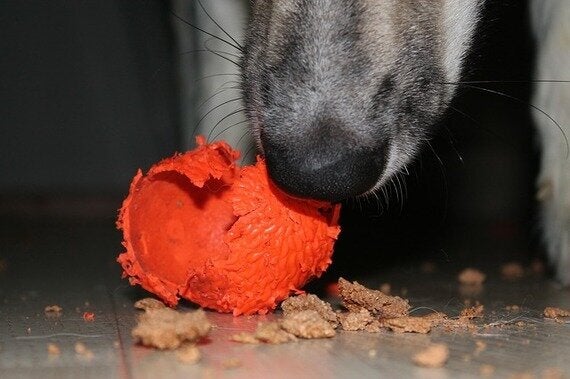Earlier this month, senior veterinarian Rebecca Ashman told The Telegraph that the People's Dispensary for Sick Animals regularly sees dogs with digestive tract damage and blockages caused by splinters or larger pieces of bone. Since then, a number of other leading organisations, including the British Veterinary Association and the Blue Cross animal welfare charity, have echoed similar warnings against giving dogs bones to chew.
It seems all of Britain's top veterinary institutions are warning dog owners that bones can prove dangerous, if not fatal.
You would think that a dog owner like myself would hear their sound advice, remove all bones from her dogs' diet, and ask no further questions. After all, bones can damage gums, get stuck in a dog's oesophagus, break teeth, and splinter sharply, lodging themselves anywhere in the gut and perforating the intestine.

But my dogs love bones. Raw, meaty bones. The more the bones look like something out of a horror film, the happier they are.
I've tried various alternatives: deer antlers (not interested), sheep hooves (interested until whatever I stuff into the feet is gone, then not interested), dental sticks (devoured without much chewing), nylon bones (they fail to recognise these as treats), and blocky chews made of tree roots that they hold in their mouths for thirty seconds before dropping onto the floor.
They look at me like, "Do you have anything by way of ribs or poultry necks?"
When I read that Andy Kershaw's beloved Schnauzer was recently killed when someone at a campsite gave his dog a bone without his knowing, and how distraught the broadcaster is over the loss, I worried yet again about the bones I give my dogs.
So I decided to invest in the Rolls Royce of non-bone chews for dogs: the Himalayan Dog Chew. Imported from the United States and costing me around £9 each, these dense chews are made from an ancient recipe of yak and cow milk, salt and lime. Some people say their dogs are absolutely addicted to them. Finally, I'd found my safe bone alternative!
While my dogs prefer real bones, they like the Himalayan Chews. I watched them set about licking and gnawing from their beds and thought how nice it was not to have to put them outside so they didn't get gristle on my carpet.
But then I heard a terrible snap and realised that one of my dogs, George, had stopped gnawing and had begun trying to break the chew apart with his teeth as he would one of the softer raw bones I've often given him.
The trouble was that in the contest between the Himalayan Dog Chew and George's teeth, the chew was winning.
I wrote to the company and received back an email stating that a few dogs (like George) just don't eat their chews correctly. Instead of softening and scraping away the cheese, they try to "break and consume," which is why the Himalayan Corporation recommends supervision with any toy or treat, and offer a range of products. They suggested I try George on one of their other products, something called a yakySTICK, which is softer.
Bones carry risks. 59 dogs were operated on this year by the PDSA over bone-related problems. But bones aren't the only danger.
Every year, foreign objects are surgically removed from dogs' abdomens. Not all of these objects are bones. What are they? Plastic toys, corn cobs, sticks, string, rubber toys, tennis balls, fishing hooks, underwear, stone fruit pips, and socks, to name a few.
Dogs will munch sticks, chew rocks, chomp on golf balls and eat your shoes. The fact that some dogs will dissect your remote control or swallow your pantyhose whole, does not make bones any safer, however.

Bones do have their upside. They are a great way of keeping teeth and gums healthy. They provide dietary minerals and they make use of an animal carcass that would otherwise be thrown away. If you feed the correct size of raw meaty bones to your dog, first getting them used to the idea of chewing and not gulping, and never leave your dog alone with a bone, you may be okay.
I say "may" because there are no guarantees. One of my rescue dogs cannot be fed any bones because he gulps them dangerously. But then, he gulps everything dangerously--even dental chews. His dinner has to be served in a puzzle bowl to stop him rushing.
Despite my best efforts, this past weekend he found a bone on one our woodland walks. One minute he was on the path beside me, the next he was hiding in the bushes, crunching through the spinal skeleton of some long-dead animal. I thought for sure he'd end up at the vet that evening--he practically inhaled the spiny, sharp skeleton--but he is a raw-fed dog so his stomach acid is pretty strong. Within hours he was impatient for his dinner, the giant bone he'd consumed floating through his digestive system without causing any harm.
So, am I telling you to give your dogs bones? Not at all. Lucky for us, dogs are incredibly versatile creatures and can be happy with any number of diets, routines, and treats.
But I am saying, however cautiously, that I know a lot of raw-fed dogs that have been carefully introduced to raw bones and haven't had a problem with them--at least not yet. And if you are looking for a magic solution that will guarantee your dog's chewing safety, you may not find it.
Photo of dog with bone by James Smith. Photo of husky chewing ball by Jocke Enroth.